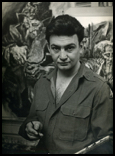
As part of the WPA project he executed a number of murals including Five large panels in fresco under the Federal Art Project in the Brodhead Naval Armory, Detroit, MI, 1937.
The Sports Pavilion on the Heinz Building of the New York World's Fair 1939. Some of his fresco and mural techniques were inspired by his friendship with Diego Rivera who had admired and encouraged him in the early 1930's.
After he won a traveling scholarship to Europe from The Museum of Modern Art at age 19, he was the recipient of two Guggenheim grants in Painting. He had his first solo exhibition at the Downtown Gallery in New York in 1937 at age 23 and many others after that including the Whitney Museum of American Art in 1947.

and Life magazine from 1943 to 1946 and his work was featured in Life Magazine regularly during the war and after until the end of his life.
Also featured in Life in 1956 were drawings that Fredenthal had vividly recorded on his sketch pad, of the entire filming of the movie, “The Pride and the Passion,” starring Cary Grant, Sophia Loren, and Frank Sinatra, along the treacherous mountain passes of Spain.
Though he was fiercely committed to an art that expressed deeply human social values and issues and was quite hostile to abstraction, he was friendly with a number of abstract artists such as David Smith, Ad Reinhardt, Philip Guston, Paul Feeley, and Herman Cherry and was very admired and respected by them as one of art history's great draftsmen.